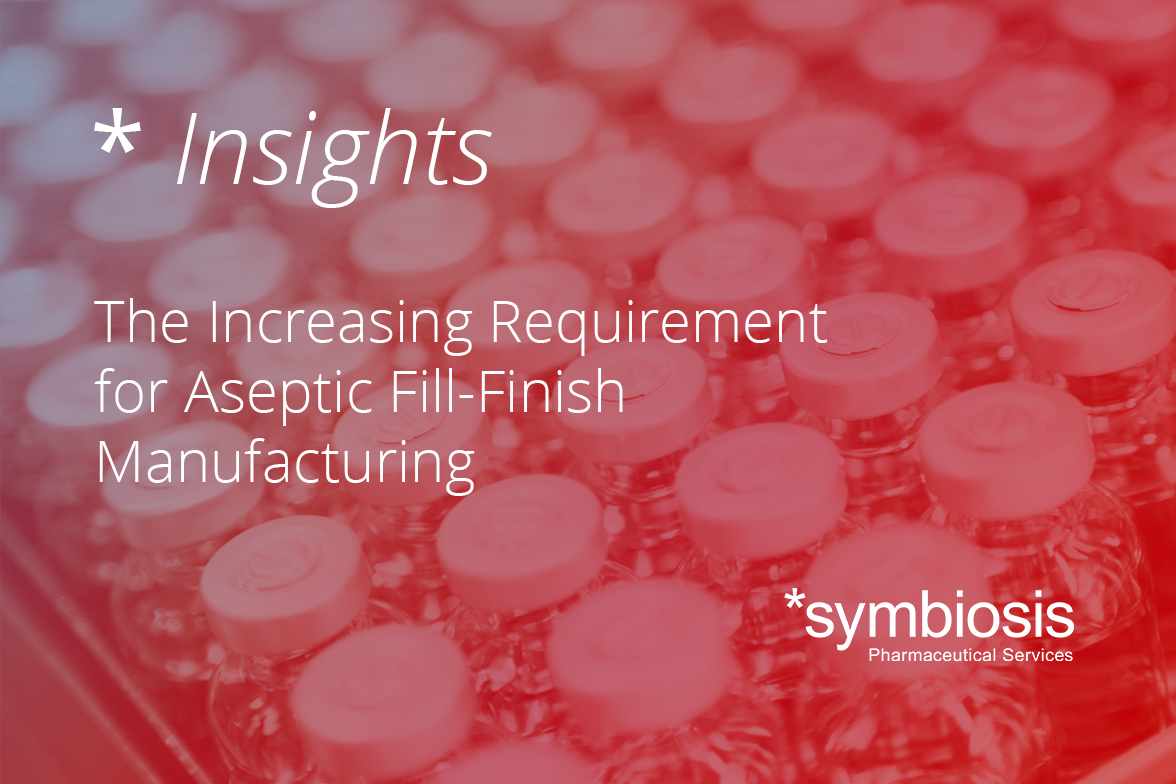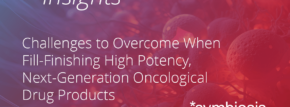Introduction
With the global spend on medicines projected to increase to $1.29tn in 2027[i], contract manufacturing organisations (CMOs) are experiencing an increased demand to fulfill aseptic fill-finish manufacturing contracts, particularly for parenteral products.
Producing such drug products under strictly controlled environmental conditions not only protects patients from contaminants but extends the drug’s shelf life[ii], making this an attractive process to maintain the integrity and efficacy of a product. Here, we explore the factors resulting in this increased demand for aseptic fill-finish and what the process entails.
Why an increase in fill finish?
According to Business Wire, there are currently more than 200 biologics commercially available and over 10,000 candidates are under clinical evaluation[iii]. Parenteral drugs, such as biologics, are designed to be administered in one of four ways:
- Intravenously
- Intramuscularly
- Subcutaneously
- Intrathecally
Due to the routes of administration, most commonly via injection or infusion, aseptic protocols are necessary to prevent microbial contamination and ultimately to safeguard patients.
The rising demand for biologics[iv], for example in the form of sophisticated, injectable oncology drugs[v], can be attributed as a driving factor in the growth of aseptically proficient CMOs. Requirements for this set of expertise have been further supported by the global need for COVID-19 vaccinations following the 2020 pandemic[vi].
With ageing populations and the associated increase in complex chronic conditions[vii], new therapeutic modalities requiring injection are being developed. Parenteral drugs are advantageous as they ensure higher bioavailability for the active substance (API) within each dose. Versus other methods of delivery e.g. oral tablets, parenterals enable lower concentrations of API to produce the required therapeutic effect. Consequently, patients benefit from both lower risk of side effects and reduced severity of side effects[viii]. Parenterals administered through intravenous injection have the added benefit of bypassing the first-pass metabolism by the liver, making this route a preferred choice by clinicians in the treatment of conditions that require high concentrations of active substances for treatment.
Regulatory bodies
CMOs and contract development & manufacturing organisations (CDMOs) are subject to region-specific regulatory bodies that issue licenses permitting the manufacture and release of drug products under aseptic conditions.
For example, UK clinical release is regulated by the Medicines and Healthcare products Regulatory Agency (MHRA) which issues guidance and best practice. In the US, the Food and Drug Administration (FDA) sets out a framework of protocols known as current good manufacturing practice (cGMP).
For the manufacture and production of parenterals and many other pharmaceuticals, CMOs must adhere to strict control measures and are subject to regular audits to ensure compliance.
Aseptic fill-finish factors
There are three forms of sterile production processes, terminal sterilisation, sterilisation by filtration and aseptic processing Terminal sterilisation is the process of sterilizing a product within its final container or vial. However, as more sophisticated molecules are being utilised, drug product formulations, are not always amenable to terminal sterilisation due to heat sensitivity.
The process of aseptic fill-finish requires a highly skilled and diligent team with breadth of expertise to successfully execute the production of aseptic, drug product batches.
Depending on the modality, formulation, and desired therapeutic effect the steps for an aseptic fill-finish are as follows:
- Drug substance production and purification
- Thawing and inspection
- Formulation and filtration
- Metered filling
- Lyophilisation (if required)
- Container closure
- Visual Inspection
- Labelling and packaging
- Certification and release
The requirements for filling necessitate a sterile environment (in the form of a cleanroom fitted with specialist equipment such as isolators and laminar flow hoods). Each piece of equipment or component of the production line must be sterilized between uses in a manner that does not impact the integrity of the drug product.
At every stage of this process, quality control is of the utmost importance and requires a team of experts dedicated to monitoring a myriad of factors including manual processing performed by technicians, atmospheric conditions, calibration of equipment, excipient testing, etc. all to prevent contaminated final product. As a drug substance is progressed through the fill-finish process, the acceptable cleanroom bioburden range lessens and the number/size of particles permitted per volume of air reduces before the vial is then assessed and finally signed off by the relevant Qualified Person (QP).
Packaging and labelling of the final drug product is of the utmost importance due to the emphasis placed on the route of administration by clinicians. This is just one factor that requires CMOs to implement agile working practices to accommodate contract-specific requirements. Due to the wide range of potential modalities from advanced therapy medicinal products (ATMPs), and small molecules to vaccines, each has their own specific set of constraints and tolerances that must be considered.
Summary
Current trends indicate that the requirement for aseptic fill-finish services is unlikely to wain[ix]. Increasing demand for fill-finish capabilities can be attributed to a combination of increased drug development pipelines, a movement towards more complex drugs (predominantly the rise in biologics), requirements for flexibility throughout manufacture and increasingly stringent regulatory stipulations.
By its very nature, the pharmaceutical manufacturing industry is in a constant state of flux to facilitate the production of innovative drug products. Many CDMOs/CMOs have been compelled to pursue automation throughout their manufacturing phases as a way to minimise time to market whilst enhancing efficiency to fulfil this demand. However, given the specialism and experience required to reliably produce sterile drug products at scale and on time, clients must consider carefully whom they seek to execute each contract.
References
[i] Mikulic,M. (2023) Global pharmaceutical industry – statistics & facts. Available at: https://www.statista.com/topics/1764/global-pharmaceutical-industry/#topicOverview [Accessed March 2023]
[ii] Root Analysis (2023) Aseptic Fill Finish Market by Type of Molecule, Type of Packaging Container Offered, Type of Drug Product, Scale of Operation, Company Size, Target Therapeutic Area and Geographical Regions: Industry Trends and Global Forecasts, 2023-2035. Available at: https://www.rootsanalysis.com/reports/aseptic-fill-finish market.html#:~:text=At%20present%2C%20the%20rising%20demand,benefits%20of%20aseptic%20fill%20finish [Accessed March 2023]
[iii] Business Wire (2023) Biologics Fill Finish Services Markets, 2035 – ResearchAndMarkets.com Available at:
https://www.businesswire.com/news/home/20230104005490/en/Biologics-Fill-Finish-Services-Markets-2035—ResearchAndMarkets.com [Accessed March 2023]
[iv] European Pharmaceutical Review, (2022) Rise of biologics set to continue, says report. Available at: https://www.europeanpharmaceuticalreview.com/news/171206/rise-of-biologics-set-to-continue-says-report/ [Accessed March 2023]
[v] Brooks,K. (2022) Contract Pharma. Parenteral Market Trends. Available at: https://www.contractpharma.com/issues/2022-03-01/view_features/parenteral-market-trends/ [Accessed March 2023]
[vi] IQVIA (2023) The Global use of medicines. Available at: https://www.iqvia.com/insights/the-iqvia-institute/reports/the-global-use-of-medicines-2023 [Accessed March 2023]
[vii] School of Medicine and Health Sciences, The George Washington University, (2010) Chronic Conditions: Making the Case for Ongoing Care. Available at: https://smhs.gwu.edu/sites/default/files/ChronicCareChartbook.pdf [Accessed March 2023]
[viii] MycoScience, Why Sterile Fill-Finish Processes Are Rising In Popularity. Available at: https://mycoscience.com/why-sterile-fill-finish-processes-are-rising-in-popularity/ [Accessed March 2023]
[ix] Allied Analytics LLP, (2023) Fill Finish Manufacturing Market : Latest Industry Trends, Trades, Supply, Demand, Prospects by 2030. Available at: https://www.einnews.com/pr_news/624713017/fill-finish-manufacturing-market-latest-industry-trends-trades-supply-demand-prospects-by-2030 [Accessed March 2023]



